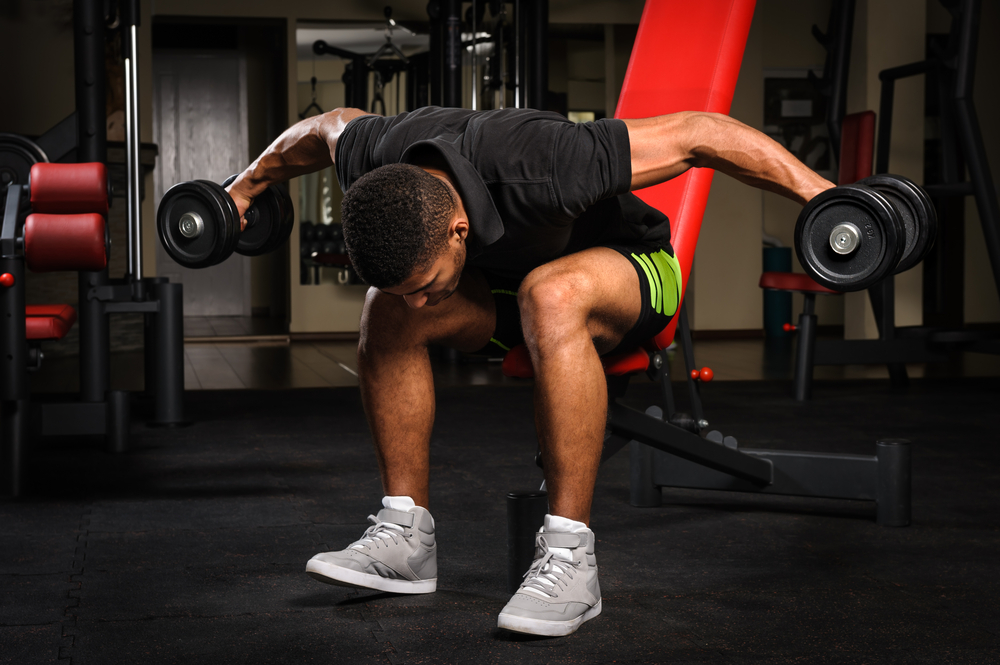We have a lot of back-building tools in the gym that target each area individually. One of the most overlooked tools, however, is the reverse pec deck. Like the bent over row, it targets the rear delts and hits them hard. However, the movement is more similar to a chest fly, except backwards. Thus, the name “reverse pec deck.”
The best alternatives to a reverse pec deck include the Bent Over Reverse Fly, Banded Rear Delt Fly, YTWs, Rear Delt Row, and Horizontal Pull Aparts. The reverse pec deck is a great exercise for targeting the rear delts. However, it’s difficult to perform without the machine. By using alternatives, you’ll be able to achieve similar results with minimal equipment.
If you’re ready to try out the reverse pec deck and other alternatives, read on!
Contents
How Do You Do a Reverse Pec Deck at Home?
Unless you happen to own a reverse pec deck machine at home, it essentially cannot be done. However, there are some alternatives that are very similar and can provide similar results. We recommend a set of bent over reverse flyes or banded rear delt flyes.
If you do happen to have a reverse pec deck machine at home or you want to use one at the gym, here’s how to do it right:
- Sit down facing the weight stack. Grab the handles so that your hands, elbows, and shoulders are on the same plane.
- Adjust the handles so they are closest to the weight stack and that they are touching or near touching at the starting position.
- Keep your chest touching the pad at all times. Shoulders should be down and torso upright and tall.
- Push the handles back and out, squeezing your back and delts as you complete the range of motion.
- At the end of the ROM, you may hold the end position and squeeze the delts. This is not a necessary step, but it is beneficial.
- Slowly return to the starting position and repeat.
Again, you’ll need a reverse pec deck machine at home in order to do this exact exercise at home. However, there are a number of home-friendly alternatives we will cover later on.
What Muscles Do Reverse Pec Deck Work?
When you complete a rep of the reverse pec deck, a lot is going on. Your shoulder blades become pinched together. Your upper and mid back feel torched. Moving the bars and gripping the handles will also employ your arms, specifically your triceps and forearms, to control the motion and the weight. A lot is happening in one simple rep.
The main areas targeted by the reverse pec deck are the rear delts, rhomboids major and minor, teres major, infraspinatus, and to a lesser extent the middle traps. Each rep will engage your back immensely and help you build and tone a great back in no time.
Pros of Reverse Pec Deck
There are many great lifts and exercises to work into your back day regimen, but the reverse pec deck is one of the best. Benefits of the reverse pec deck include:
- Isolates rear delts and upper back
- Contributes to hypertrophy
- Increases overall strength
- Improves posture
- Improves stability
- Engages muscles differently from other lifts
There’s a lot to love. Like many other back-focused exercises, you will build size and strength over time. Your core and trunk strengthen, granting you a better posture along with better stability and balance.
Where the reverse pec deck really shines, however, is that it’s different from many other back-focused lifts and exercises. Back day employs a lot of lifts that require pulling. The reverse pec deck, on the other hand, requires pushing and squeezing the back at the end of each rep. This varies the movements during back day and contributes to better overall results.
Cons of Reverse Pec Deck
The reverse pec deck is a fantastic exercise to work into your routine. However, there are a number of drawbacks associated with this exercise.
The most notable con is that the movement requires a specific machine to perform. You could try to get a similar result standing and using dumbbells, but adjustments are needed to compensate. To truly perform the reverse pec deck movement, you need to be on that specific machine.
Another drawback is that the movement is unique, so it will feel awkward at first. We can mitigate this con with some practice. Failing to keep good form or resorting to jerky movements to get through the movement will only encourage injury. It’s important to try the movement slowly with minimal weight at first to overcome the awkward feeling. Once this is done, you may scale as your abilities dictate.
Reverse Pec Deck Alternatives
If you don’t have access to a reverse pec deck machine, fear not! There are many great alternatives to the reverse pec deck. Many target the same muscles to provide you with the same level of results. In addition, some require little or no equipment at all!
1) Bent Over Reverse Fly
This exercise is one of the best alternatives because it’s simple, requires minimal space to perform, and only requires two dumbbells. The movement is extremely similar to the actual reverse pec deck, but the application is slightly different.
Here’s how to perform the bent over reverse fly:
- From a standing position, hinge at the hips and bend your knees slightly to create an incline to your torso. Keep your back straight and your core tight.
- Dangle arms in front of your body, holding dumbbells with your palms facing each other.
- Slightly bend your elbow as you would during a chest fly.
- Pull arms up and away, squeezing your back at the top of the movement.
- Return to the starting position and repeat as needed.
There is a way to perform the bent over reverse fly from a seated position at the end of a bench. However, the standing version provides the added benefit of engaging your lower back too. The bent over reverse fly, like the reverse pec deck, is great for your rear delts, rhomboids, and trapezius muscles.

2) Banded Rear Delt Fly
The banded rear delt fly targets basically the same exact muscle group as the reverse pec deck. All you need to get it done is a resistance band, or a few with varying resistances, and an anchor. The anchor could be a sturdy, heavy object or even a door.
Here’s how it’s done:
- Anchor the band to an object and hold each handle at chest height
- Trade handles with your other hand. The band should make a crisscross.
- Raise your arms to your shoulders and step back until there is tension in the band.
- Bend slightly at your elbows.
- Pull the handles out and away in the same fashion as the reverse pec deck.
- Squeeze the shoulder blades together at the end of the movement.
- Slowly return to the starting position.
- Repeat the movement as needed.
The banded rear delt fly is better than the reverse pec deck in that you can do it just about anywhere. However, you’ll tackle more weight on the machine than with a series of resistance bands and therefore get better results faster.
3) YTWs
YTWs are great for toning the back, especially the lower traps. This contributes to healthier shoulders and better posture. It’s great if you’re at home with very little or no equipment.
However, stacking weight on a reverse pec deck machine will be overall better for strength and size building.
Here’s how to do YTWs:
- Lie face down on the floor. We recommend a small cushion for your forehead.
- Raise your arms overhead in a “Y.” Your thumbs should point up toward the ceiling.
- Squeeze the shoulder blades together and lift your arms off the floor.
- Return your arms to the ground. Repeat 10 times.
- Move your arms out to the sides and form a “T.” Your palms should face the ground.
- Squeeze the shoulder blades and lift your arms off the floor.
- Return your arms to the ground. Repeat 10 times.
- Keep your palms facing the ground, bend your elbows, and pull them into the sides of the body to form a “W.”
- Squeeze the shoulder blades together and lift your arms off the floor.
- Return your arms to the ground. Repeat 10 times.
- Repeat for the desired number of sets.
It will take time to move through all reps so take things slow, especially at first. YTWs won’t give you massive gains like lifting heavy would, but it’s still effective. Plus, it makes a great warm-up for other lifts.
4) Rear Delt Row
The rear delt row is similar to the bent over row but with dumbbells instead of a barbell. Having each weight isolated allows the body a wider range of motion, targeting the delts even harder.
Here’s how the movement is done:
- From a standing position, hinge at the hips and bend your knees slightly to create an incline to your torso. Keep your back straight and your core tight.
- Dangle arms in front of your body, holding dumbbells with your palms facing each other.
- Bring arms up to the body, bending at the elbows as you pull the dumbbells upwards.
- Squeeze your shoulder blades at the top of the movement.
- Lower the weight back down and return to the starting position.
- Repeat the movement as needed.
Like the bent over row, you’ll hit your delts, rhomboids, and trapezius muscles as well as your triceps. If you don’t have a reverse pec deck machine but can get your hands on some dumbbells, consider adding a set of rear delt rows instead.
5) Horizontal Pull Aparts
Got a resistance band? Good, because that’s all you need to get in a set of horizontal pull aparts.
Here’s how they’re done:
- Grab a resistance band keeping your hands shoulder-width apart.
- Squeezing your shoulder blades together, pull the band apart until your arms are fully extended.
- Slowly return to the starting position.
- Repeat the movement as needed.
Like YTWs and banded rear delt flyes, this is an easy movement to do just about anywhere with very minimal equipment. You’ll target the delts, rhomboids, and traps. However, you won’t hit these muscles quite as hard as you would with a set of dumbbells or a reverse pec deck machine.



